
Tech major IBM has unveiled the latest version of its mainframe hardware engineered to support artificial intelligence (AI) across software, hardware, and systems operations.
Powered by the IBM Telum II processor, the IBM z17 is designed to extend beyond transactional AI workloads, aiming to deliver real-time analysis for 100% of enterprise transactions.
The system introduces capabilities that process up to 50% more AI inference operations per day than its predecessor, the IBM z16.
The z17 incorporates feedback from more than 100 enterprise clients and reflects a five-year development process, the company said.
The company revealed that it filed more than 300 patent applications with the US Patent and Trademark Office during this period.
The new system integrates AI to support over 250 use cases such as risk assessment for loans, chatbot management, among others.
At the core of the z17 is a second-generation on-chip AI accelerator within the Telum II processor, offering 40% more cache and the ability to perform over 450 billion inferencing operations daily with one millisecond response times.
Concurrently, the tech major previewed the IBM Spyre Accelerator which will offer additional AI compute capacity via a PCIe card.
The accelerator is intended to enable generative AI capabilities on the mainframe, such as AI assistants using enterprise data.
The z17 introduces tools like IBM watsonx Code Assistant for Z and IBM watsonx Assistant for Z to enhance developer and IT operations productivity.
For the first time, watsonx Assistant for Z will integrate with Z Operations Unite to provide chat-based AI incident detection and resolution using live system data, the company said.
IBM also introduced IBM Z Operations Unite, a solution designed to unify key performance metrics and logs using OpenTelemetry.
Scheduled for general availability in May 2025, it is aimed at improving incident detection, impact assessment, and resolution times.
The z17 also includes features such as IBM Vault for secrets management across hybrid cloud, leveraging technology from HashiCorp.
Additionally, the system introduces AI-powered tools for data classification and threat detection, including IBM Threat Detection for z/OS.
Support for the z17 will be provided through IBM Technology Lifecycle Services, offering AI-driven processes to enhance case resolution and operational efficiency.
The z17 will be generally available from 18 June 2025, with the IBM Spyre Accelerator to follow in late 2025.
IBM LinuxONE and IBM Z general manager Ross Mauri said: “The industry is quickly learning that AI will only be as valuable as the infrastructure it runs on.
“With z17, we’re bringing AI to the core of the enterprise with the software, processing power, and storage to make AI operational quickly. Additionally, organisations can put their vast, untapped stores of enterprise data to work with AI in a secured, cost-effective way.”
Recently, IBM and Tokyo Electron (TEL) renewed their partnership to advance semiconductor technologies for the next five years.







